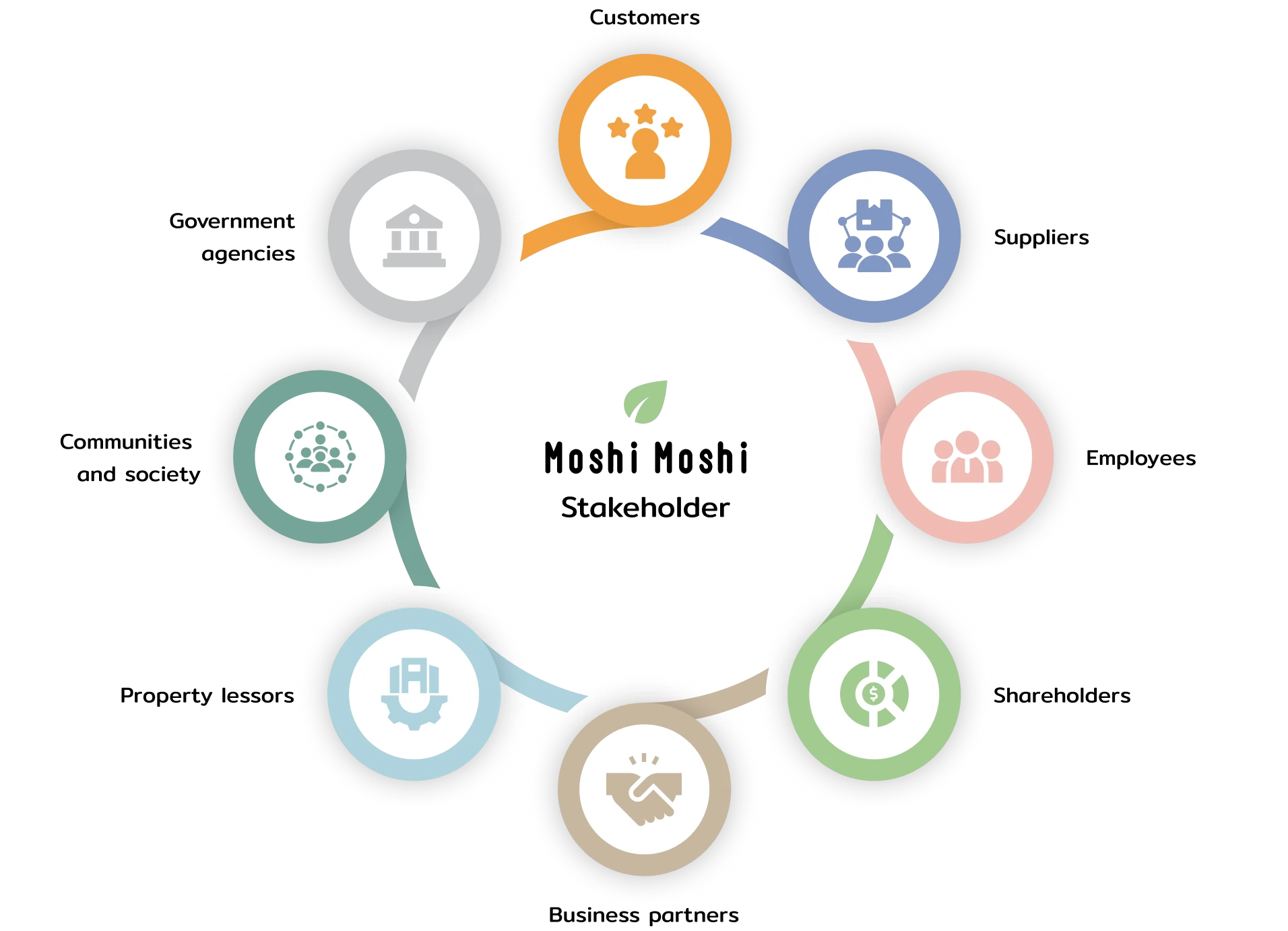
Stakeholder Engagement
The Company recognizes that sustainable business operations must consider the impacts and expectations of all related stakeholder groups.
Therefore, it has conducted analysis and identification of stakeholders who have direct and indirect relationships with the business value chain, categorizing them into 8 main groups: customers, Suppliers, employees, shareholders, business partners, property lessors, communities and society, and government agencies. To ensure effective stakeholder management
The Company has established systematic work processes following the sustainability data development framework of the Stock Exchange of Thailand, which encompasses annual stakeholder analysis reviews, development of appropriate participation channels and communication methods, as well as systematic establishment of approaches to respond to each group's expectations. The assessment results are presented to the Board of Directors with continuous monitoring. Furthermore, participation in the sustainability data development project with the Stock Exchange has enabled the Company to receive guidance and support from experts, which confirms that the Company's work processes comply with standards and best practices, leading to effective and successful development of strategies and implementation of sustainable business plans.
The Company conducts sustainability materiality analysis by referencing the approach of the Stock Exchange of Thailand and international reporting standards (Global Reporting Initiative: GRI Standards). The Company has collected and analyzed data from various sources, including comparisons with companies in the same or similar industries both domestically and internationally, ESG Metrics for the services sector from the Stock Exchange of Thailand, as well as data from credit rating institutions such as MSCI and S&P Global, and considers comparisons with the previous year's prioritization results, alongside consideration of business context changes arising from various factors such as business direction, stakeholder behavior, and government policies to establish clear sustainability issues for annual impact assessment and prioritization.
Analysis of Stakeholders in the Business Value Chain
The company places importance on both internal and external stakeholders, having analyzed and identified stakeholders who have direct and indirect relationships with the business value chain in order to manage these relationships appropriately. The company divides stakeholders into 8 main groups: customers, suppliers, employees, shareholders, business partners, property lessors, communities and society, and government agencies. Sustainable business operations require consideration of the impacts and expectations of each stakeholder group, as each group has different needs and expectations.
- Develop, design, and sell diverse products at appropriate prices
- Good quality service both before and after sales
- Protection of personal data security
- Receiving accurate and timely information about products and various activities
- Develop, design, and sell diverse products at appropriate prices
- Organize activities, promotions, or special privileges
- Provide complaint channels through company platforms
- Develop customer data management systems to store personal information securely
- Create content to communicate with customers accurately and in a timely manner through various channels
- Regularly train employees to provide good service to customers
- Annual customer satisfaction survey
- Suggestions or complaints
- Social media / Email
- Consultation
- Fair trade
- Joint development and growth together
- Increased purchase orders
- Conducting business with transparency
- Timely management and payment
- Purchase planning
- Treat partners equally
- Have clear procurement processes
- Comply with trade rules and conditions
- Ensure complete and timely payments
- Collaborate on product development
- Declare intent and join the Thai private sector collective action against corruption
- Joint meetings
- Visiting partner factories
- Suggestions or complaints
- Fair compensation and good benefits
- Career advancement
- Respect for human rights
- Participation in the organization through expressing opinions
- Safety, occupational health, and work environment
- Efficient tools and work systems
- Pay appropriate and fair compensation and benefits that are competitive in the labor market
- Provide training in skills related to job responsibilities and development opportunities for growth within the organization
- Listen to opinions and suggestions for improvement
- Organize activities to promote relationships and create engagement
- Provide a safe working environment and appropriate tools sufficient for work
- Announcement boards
- Monthly meetings
- Intranet
- One-on-one meetings
- Satisfaction surveys
- Regular employee training
- Assignment of KPIs for work and performance monitoring
- Return on operational performance
- Accurate, complete, and timely disclosure of information and operational results of the company
- Protection of rights and equality
- Strategies, plans, and development direction for business growth
- Good corporate governance
- Accurate and timely disclosure of information
- Transparent business operations in accordance with good corporate governance principles
- Providing opportunities for shareholders to offer opinions and complaints directly to the company
- Focusing on creating continuous long-term returns
- Analyst Meeting, Listed Company Meeting with Investors (Opportunity Day)
- Annual information in Form 56-1 One Report
- Shareholders' Meeting
- Company visits
- News notifications through the Stock Exchange
- Company complaint channels
- Conduct business to maximize benefits and respond to the goals of all parties in the organization without disadvantaging anyone (Win-Win solution)
- Operate with trustworthiness, transparency, and accountability
- Selecting partners who share the same business vision
- Focusing on operational development and strictly adhering to agreements or contracts between parties
- Joint meeting
- Receiving cooperation and quick problem resolution
- Receiving rent payments on time
- Maintaining rental premises in good condition
- Organizing activities to attract more customers to the rental location
- Sales growth
- Comply with trade rules and conditions
- Make payments according to terms and on time
- Have measures to maintain the rented space
- Continuously organize activities to attract customers to purchase products
- Joint meetings
- Contracts
- Listen to and help develop society, including the quality of life for people in the community
- Prioritize safety and care for the environment
- Support and promote activities that benefit the community
- Study, understand and listen to voices from the community to provide appropriate responses
- Create jobs, career opportunities, and income for the community
- Preserve the ecosystem and environment surrounding warehouses and branches
- Annual information in Form 56-1 One Report
- Social media / Email
- Suggestions or complaints
- Organize activities with the community
- Comply with the law and promote good corporate governance
- Equal and fair competition
- Support and cooperate in various activities
- Handle complaints efficiently
- Conduct business with transparency, fairness, accountability, and in compliance with the law
- Disclose information with complete transparency
- Support and cooperate in various activities
- Listen to and exchange opinions
- Organize activities with government networks
- Social media / Email

Analysis of Stakeholders in the Business Value Chain
The company places importance on both internal and external stakeholders, having analyzed and identified stakeholders who have direct and indirect relationships with the business value chain in order to manage these relationships appropriately.

